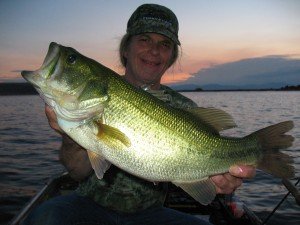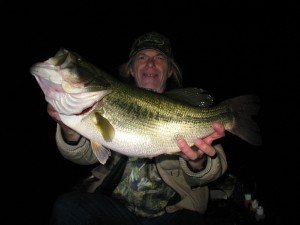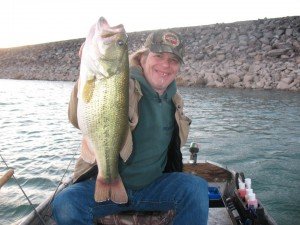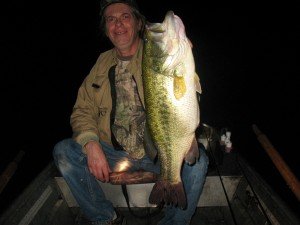 Just weeks after ice-out (May in Northern Minnesota), or frigid open waters, the first spring migrations of giant bass begins. I’ve been following these first movements of giant bass for five decades, and specifically target the largest bass in any systems I fish during this time frame of initial migrations. Largemouth bass and Smallmouth bass annual movements take place from main lake basins to migratory routes, and eventually to secondary staging areas. Many anglers fail to realize the potential of the off-shore main lake basin program for early season giants. In states that have open bass seasons early in the year, or special catch and release programs, targeting these first initial big bass movements can bode well for boating some of the heaviest bass of the year.
Just weeks after ice-out (May in Northern Minnesota), or frigid open waters, the first spring migrations of giant bass begins. I’ve been following these first movements of giant bass for five decades, and specifically target the largest bass in any systems I fish during this time frame of initial migrations. Largemouth bass and Smallmouth bass annual movements take place from main lake basins to migratory routes, and eventually to secondary staging areas. Many anglers fail to realize the potential of the off-shore main lake basin program for early season giants. In states that have open bass seasons early in the year, or special catch and release programs, targeting these first initial big bass movements can bode well for boating some of the heaviest bass of the year.
The instinct to spawn, in combination with warming weather trends and slowly rising water temperatures, triggers the first initial movements.
Specific weather elements that create prime bite windows can increase giant bass movements and activity levels early in the season. Two to three day warming trends, strong southerly winds, and weather windows in between early season fronts following stable weather are prime times to be on the water in search of the largest fish in the system.
One of the most important factors is bass locations throughout the water column. During specific times, bass will be locating near bottom as they slowly migrate to secondary and primary staging grounds. As water temperatures warm, bass may locate higher in the water column and move in larger groups toward their preferred yearly spawning areas. These migrations can be stalled by quick barometric pressure change caused by multiple early season frontal passages, causing these large groups of fish to vertically stack through the water column.
Staying astute with your electronics will be a key to focus on exact bass positioning and reading activity levels throughout the day or night. Bite window time frames can vary from being short to intense or, during the perfect situation, last more than 2 hours. When every factor aligns, multiple giant bass can be the norm with the proper presentations for each individual mode of activity level.
I’m following big fish at this time of the season and watching every weather scenario, along with small increments of water temperature changes. Many times, the north sections of bodies of water warm quicker as the Southerly winds blow warmer water into these sections of the waters you target.
Knowing where main lake basin movements begin on the waters you fish, or being able to eliminate dead water fast on new waters, is a crucial factor to being consistent on big fish during the initial migration period. Once these off-shore bass are located and activity levels are factored in, a variety of presentations will trigger specific fish in various modes of neutral to semi-active in frigid water conditions.
 I use a wide variety of presentations, but part of all my presentations remains the same.
I use a wide variety of presentations, but part of all my presentations remains the same.
Dead-Sticking. Big fish in water temperatures in the high 30’s to high 40’s don’t tend to chase down baits very often. Selecting presentations that can trigger bass with a miniscule strike zone is the deal here. I tend to keep it simple until water temps hit the 48 to 50 degree mark. Various weighted jig combos cover a variety of depths from 28 to 55 or 60 feet, bladed swim-jigs for lifting and dropping, small beaver style grubs with a mushroom head style jig, soft plastic fluke style minnow baits, a variety of jigging spoons (even ice fishing jigs) and a float’n’ fly rig can be a simple but effective groups of presentations to fish precisely through the entire water column.
As the water hits the 50 degree mark, I add soft plastic and hard jerk baits, along with deep running cranks to the program. For trophy smallies, we run fluke style baits directly below the boat, straight vertical at various depth levels. Dead-stick these baits from 12-25 or 30 feet depending on smallmouth locations through the water column. As smallies become a bit more active, we raise the bait higher in the water column as smallies are looking up for the first baitfish pods of the season. These fish will rise to take baits fished only 12-15 feet below the boat.
 For Largemouth presentations, the aforementioned groups of select baits will cover essentially the entire water column. We do a lot of strolling and dead-sticking baits this time of the season to cover certain areas of the waters we fish. Smaller to medium size swim baits come into play with water temperatures at 48 or above.
For Largemouth presentations, the aforementioned groups of select baits will cover essentially the entire water column. We do a lot of strolling and dead-sticking baits this time of the season to cover certain areas of the waters we fish. Smaller to medium size swim baits come into play with water temperatures at 48 or above.
Long line strolling with these baits and stopping and dead-sticking them on exact spots on spots throughout the main lake basins has produced giant bass through the decades for us all over the country.
Select small increments in bottom change contours, off-shore humps, filter fingers leading from deep structures with a variety of quick depth changes that offer areas for fish to move, and then find a comfort zone during Spring fronts.
A difference of a few feet or so in main lake basin zones will be a perfect holding zone for big bass filtering in. During any post-front scenarios this time of the season and even further on into Spring, these areas hold groups of stalled giants. Being able to read every situation you encounter on the water this time of the year including wind velocity and direction, small increases in water temps across the lake, specific weather elements, bass positioning and activity levels based on all these factors combined, will enable you to focus on exact presentations needed to trigger early season or Ice-Out bass.
Bites can be very subtle most times, so stay focused 100% of the time, be patient, read what is going on around you on any specific trip, dead-stick your presentations, return to prime zones that hold giant bass frequently throughout the day and be ready for some early season big fish action this season.
 * In-Fisherman Contributor, Veteran Trophy Bass Specialist and Freelance Outdoor Writer Brett Richardson has been chasing multi-species giant fish for well over five decades. He offers a 15 Title season within season Giant Bass Series Dvd Collection created to help you triple your catch rates for giant bass. E-mail [email protected] for orders of any of his Dvd Collection.
* In-Fisherman Contributor, Veteran Trophy Bass Specialist and Freelance Outdoor Writer Brett Richardson has been chasing multi-species giant fish for well over five decades. He offers a 15 Title season within season Giant Bass Series Dvd Collection created to help you triple your catch rates for giant bass. E-mail [email protected] for orders of any of his Dvd Collection.